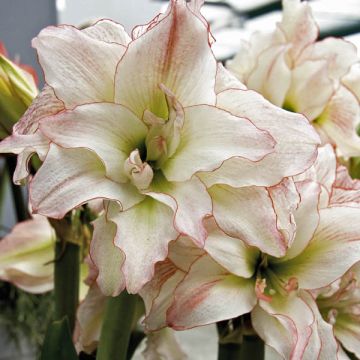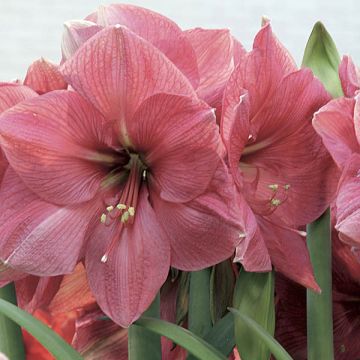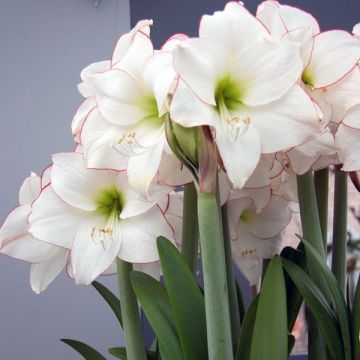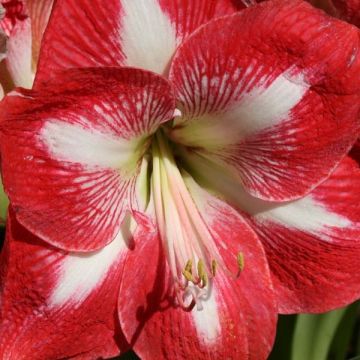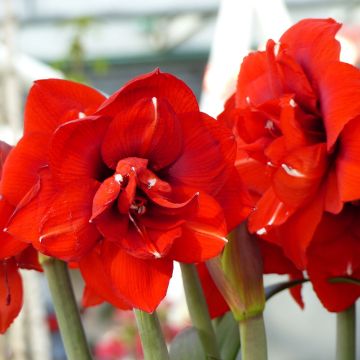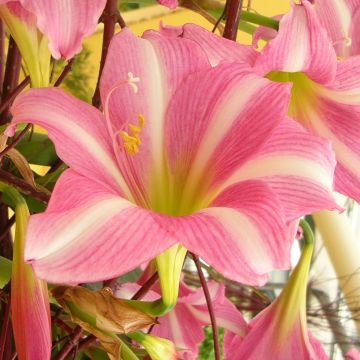

Hippeastrum Nymph - Amaryllis


Hippeastrum Nymph - Amaryllis


Hippeastrum Nymph - Amaryllis
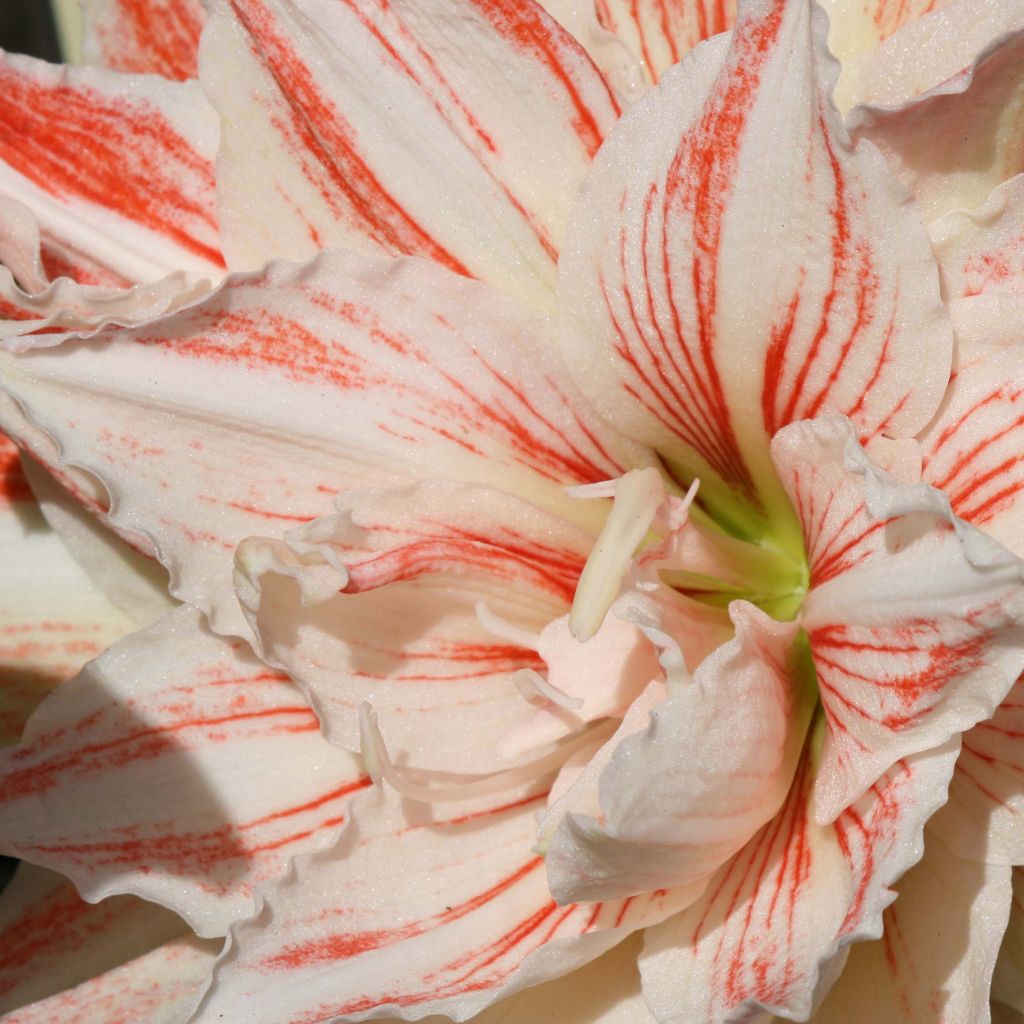

Hippeastrum Nymph - Amaryllis


Hippeastrum Nymph - Amaryllis
Hippeastrum Nymph - Amaryllis
Hippeastrum Nymph
Amaryllis, Knight's-star-lily
Patience is rewarded, day after day it evolves slowly... it grows gently and the result is magnificent.
Caro, 21/01/2024
Why not try an alternative variety in stock?
View all →This plant carries a 6 months recovery warranty
More information
We guarantee the quality of our plants for a full growing cycle, and will replace at our expense any plant that fails to recover under normal climatic and planting conditions.
From €5.90 for pickup delivery and €6.90 for home delivery
Express home delivery from €8.90.

Does this plant fit my garden?
Set up your Plantfit profile →
Description
Hippeastrum 'Nymph' is a variety with voluptuous and fully double flowers, randomly and delicately striped with soft coral-pink on the white and iridescent background of their fleshy petals. With their round shape and duplication, they somewhat resemble peonies. These beautiful blooms bring spring into the house in the midst of winter. It is a bulbous plant that is very easy to grow. It will bloom in the house with a dazzling flowering that lasts several weeks.
Originating from subtropical regions of Central and South America, hippeastrum are frost-sensitive plants belonging to the Amaryllidaceae family. They are generally grown in pots in our latitudes. In full bloom, the 'Nymph' variety forms a clump 50 to 60cm (20 to 24in) in height and 30cm (12in) in width. It produces double flowers, measuring up to 15cm (6in) in diameter, composed of numerous wide and round petals, with a thick and waxy texture. They are mostly white, adorned with tiny iridescent flakes and lightly brushed with light pink-red streaks. Positioned back-to-back at the top of long hollow stems, the flowers form a unique composition. As they do not all bloom at the same time, the flowering can last for more than a month.
Growing an amaryllis is a very rewarding experience. Hippeastrum is very easy to grow and its growth is extremely rapid. The flowers bloom 6 to 10 weeks after planting. You can enjoy them throughout winter. Plant it at the beginning of November if you want to give it as a Christmas gift. Ideally, position it in the sun, in front of a window for example. Trim the stem when the flowers fade to promote floral regrowth.
If there is confusion between Amaryllis and Hippeastrum, it is because Linnaeus gave the same name to this species native to South America and to another species native to South Africa. Since then, by convention, it is appropriate to use the name Hippeastrum for the American Amaryllis and Belladonna for the South African Amaryllis. The truth is that both species deserve this appellation, which means "haughty beauty".
Report an error about the product description
Hippeastrum Nymph - Amaryllis in pictures


Plant habit
Flowering
Foliage
Botanical data
Hippeastrum
Nymph
Amaryllidaceae
Amaryllis, Knight's-star-lily
Cultivar or hybrid
Other Hippeastrum - Amaryllis
Planting and care
You can plant 'Nymph' bulbs from October to the end of April. Choose a pot that is not too big (one or two cm larger than the size of the bulb). Place a layer of drainage at the bottom for proper water flow. Mix half potting soil, half garden soil. Only bury the bulb halfway. Place the pot in a warm and bright location. Water sparingly until the stem appears. Then water daily. Your bulbs will flower 6 to 8 weeks later.
If you choose multiple bulbs, plant them with a two-week interval to enjoy their beauty throughout winter.
After flowering, remove the faded flowers and let the leaves continue to grow. Continue to water regularly and give them indoor plant fertiliser every 15 days. This is when the bulb replenishes itself to prepare for next year's flowers. After 4 to 6 months, forget about your potted plants, and let them rest for about 3 months in a sheltered location. You can then trim the faded leaves, repot them in fresh soil, and start a new growing cycle.
Planting period
Intended location
Care
-
, onOrder confirmed
Reply from on Promesse de fleurs
Haven't found what you were looking for?
Hardiness is the lowest winter temperature a plant can endure without suffering serious damage or even dying. However, hardiness is affected by location (a sheltered area, such as a patio), protection (winter cover) and soil type (hardiness is improved by well-drained soil).

Photo Sharing Terms & Conditions
In order to encourage gardeners to interact and share their experiences, Promesse de fleurs offers various media enabling content to be uploaded onto its Site - in particular via the ‘Photo sharing’ module.
The User agrees to refrain from:
- Posting any content that is illegal, prejudicial, insulting, racist, inciteful to hatred, revisionist, contrary to public decency, that infringes on privacy or on the privacy rights of third parties, in particular the publicity rights of persons and goods, intellectual property rights, or the right to privacy.
- Submitting content on behalf of a third party;
- Impersonate the identity of a third party and/or publish any personal information about a third party;
In general, the User undertakes to refrain from any unethical behaviour.
All Content (in particular text, comments, files, images, photos, videos, creative works, etc.), which may be subject to property or intellectual property rights, image or other private rights, shall remain the property of the User, subject to the limited rights granted by the terms of the licence granted by Promesse de fleurs as stated below. Users are at liberty to publish or not to publish such Content on the Site, notably via the ‘Photo Sharing’ facility, and accept that this Content shall be made public and freely accessible, notably on the Internet.
Users further acknowledge, undertake to have ,and guarantee that they hold all necessary rights and permissions to publish such material on the Site, in particular with regard to the legislation in force pertaining to any privacy, property, intellectual property, image, or contractual rights, or rights of any other nature. By publishing such Content on the Site, Users acknowledge accepting full liability as publishers of the Content within the meaning of the law, and grant Promesse de fleurs, free of charge, an inclusive, worldwide licence for the said Content for the entire duration of its publication, including all reproduction, representation, up/downloading, displaying, performing, transmission, and storage rights.
Users also grant permission for their name to be linked to the Content and accept that this link may not always be made available.
By engaging in posting material, Users consent to their Content becoming automatically accessible on the Internet, in particular on other sites and/or blogs and/or web pages of the Promesse de fleurs site, including in particular social pages and the Promesse de fleurs catalogue.
Users may secure the removal of entrusted content free of charge by issuing a simple request via our contact form.
The flowering period indicated on our website applies to countries and regions located in USDA zone 8 (France, the United Kingdom, Ireland, the Netherlands, etc.)
It will vary according to where you live:
- In zones 9 to 10 (Italy, Spain, Greece, etc.), flowering will occur about 2 to 4 weeks earlier.
- In zones 6 to 7 (Germany, Poland, Slovenia, and lower mountainous regions), flowering will be delayed by 2 to 3 weeks.
- In zone 5 (Central Europe, Scandinavia), blooming will be delayed by 3 to 5 weeks.
In temperate climates, pruning of spring-flowering shrubs (forsythia, spireas, etc.) should be done just after flowering.
Pruning of summer-flowering shrubs (Indian Lilac, Perovskia, etc.) can be done in winter or spring.
In cold regions as well as with frost-sensitive plants, avoid pruning too early when severe frosts may still occur.
The planting period indicated on our website applies to countries and regions located in USDA zone 8 (France, United Kingdom, Ireland, Netherlands).
It will vary according to where you live:
- In Mediterranean zones (Marseille, Madrid, Milan, etc.), autumn and winter are the best planting periods.
- In continental zones (Strasbourg, Munich, Vienna, etc.), delay planting by 2 to 3 weeks in spring and bring it forward by 2 to 4 weeks in autumn.
- In mountainous regions (the Alps, Pyrenees, Carpathians, etc.), it is best to plant in late spring (May-June) or late summer (August-September).
The harvesting period indicated on our website applies to countries and regions in USDA zone 8 (France, England, Ireland, the Netherlands).
In colder areas (Scandinavia, Poland, Austria...) fruit and vegetable harvests are likely to be delayed by 3-4 weeks.
In warmer areas (Italy, Spain, Greece, etc.), harvesting will probably take place earlier, depending on weather conditions.
The sowing periods indicated on our website apply to countries and regions within USDA Zone 8 (France, UK, Ireland, Netherlands).
In colder areas (Scandinavia, Poland, Austria...), delay any outdoor sowing by 3-4 weeks, or sow under glass.
In warmer climes (Italy, Spain, Greece, etc.), bring outdoor sowing forward by a few weeks.

































